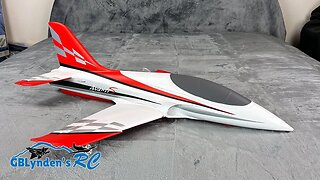Premium Only Content

Parkzone FW-190 BNF Second Flight - Focke-Wulf 190A-8 WWII RC Warbird
This is the second flight with my new Parkzone FW-190 WWII RC Warbird or Parkzone Focke-Wulf 190A-8 Bind-N-Fly Basic or BNF Basic. It is often referred to as the the Butcher Bird. It was a dirty bird in the Luftwaffe of Nazi Germany during World War Two.
Here is a link to my Amazon Store to help support the channel and keep it independent: https://www.amazon.com/shop/gblyndensrc
This Parkzone FW-190 parkflyer WWII Warbird RC Plane flight video contains fun flight footage of me flying this beautiful RC Plane.
This RC Plane Park Flyer is brought to us by RC juggernaut Horizon Hobby. This is also a favorite of many WWII Warbird fans and may be one of the better PZ Parkflyer options they have ever released under their Parkzone brand.
Overall this is a great RC Warbird with a few little quirks to work around. I got most of them worked out before the second flight, which was a very fun second flight!
I am also happy to report that I did not crash on my maiden or this second flight. That is always a nice feeling, especially when it is being used for an unboxing and review video :)
This one is just one cool airplane in a line-up of other WWII Warbirds such as the P-47 Thunderbolt, F4F Wildcat, T-28 Trojan, Parkzone Corsair, and P-51 Mustang Parkzone. Hopefully they will add in a P-38, P-40, or a B-17 in the near future. I hope they are also as well built as my PZ FW-190 or PZ Focke-Wulf 190. Its technical name is the Parkzone FW-190a-8.
A bit of history on this plane is mentioned below:
During World War II, few sights could make an Allied pilot's blood run cold like that of a Focke-Wulf 190 headed his way. So fearsome was this fighter's reputation that it was known to friend and foe alike as the "Butcher Bird."
The Focke-Wulf Fw 190 Würger (English: Shrike) was a German single-seat, single-engine fighter aircraft designed by Kurt Tank in the late 1930s and widely used during World War II. Powered by a radial engine in most versions, the Fw 190 had ample power and was able to lift larger loads than its well-known counterpart, the Messerschmitt Bf 109. The Fw 190 was used by the Luftwaffe in a wide variety of roles, including day fighter, fighter-bomber, ground-attack aircraft and, to a lesser degree, night fighter.
When the Fw 190 started flying operationally over France in August 1941, it quickly proved itself to be superior in all but turn radius to the Royal Air Force's main front-line fighter, the Spitfire Mk. V,[2] especially at low and medium altitudes. The 190 maintained superiority over Allied fighters until the introduction of the improved Spitfire Mk. IX in July 1942 restored qualitative parity.[3] The Fw 190 made its air combat debut on the Eastern Front in November/December 1942; though Soviet pilots considered the Bf 109 the greater threat, the Fw 190 made a significant impact.
The Fw 190 became the backbone of the Jagdwaffe (Fighter Force), along with the Bf 109. On the Eastern Front, the Fw 190 was versatile enough to use in Schlachtgeschwader (Battle Wings or Strike Wings), specialised ground attack units which achieved much success against Soviet ground forces. As an interceptor, the Fw 190 underwent improvements to make it effective at high altitude, enabling it to maintain relative parity with its Allied opponents. The Fw 190A series' performance decreased at high altitudes (usually 6,000 m (20,000 ft) and above), which reduced its effectiveness as a high-altitude interceptor, but this problem was mostly rectified in later models, particularly in the Junkers Jumo 213 inline-engine Focke-Wulf Fw 190D series, which was introduced in September 1944.
The A-8 entered production in February 1944, powered either by the standard BMW 801 D-2 or the 801Q (also known as 801TU). The 801Q/TU, with the "T" signifying a Triebwerksanlage unitized powerplant installation, was a standard 801D with improved, thicker armour on the front annular cowling, which also incorporated the oil tank, upgraded from 6 mm (.24 in) on earlier models to 10 mm (.39 in). Changes introduced in the Fw 190 A-8 also included the C3-injection Erhöhte Notleistung emergency boost system to the fighter variant of the Fw 190 A (a similar system with less power had been fitted to some earlier Jabo variants of the 190 A), raising power to 1,980 PS (1,953 hp, 1,456 kW) for a short time.
-
 7:43
7:43
GBLynden's RC
11 months agoNew Jet Unboxing | Arrows RC Avanti S 50mm EDF Jet
224 -
 7:22
7:22
Dr David Jockers
16 hours ago $0.10 earned1 Teaspoon Per Day Burns Belly Fat Quickly
228 -
 1:21:34
1:21:34
Josh Pate's College Football Show
1 day ago $17.50 earnedWeek 11 Reaction Show: Alabama Rolls LSU | Ole Miss Owns UGA | Miami Falls | AP Poll vs JP Poll
55.7K6 -
 30:01
30:01
Shrouded Hand
1 day ago $11.83 earnedThree Disturbing Missing Child Cases
36.6K10 -
 8:27
8:27
Rethinking the Dollar
19 hours agoHow to Navigate the Crypto Boom vs. Metals Drop in 2024
23.5K5 -
 1:00:23
1:00:23
PMG
17 hours ago $8.43 earned"The Dark Alliance of Big Pharma & Big Food w/ Dr. Tenpenny"
20.6K5 -
 0:44
0:44
OfficialJadenWilliams
14 hours agoiPhone password
13.1K9 -
 13:16
13:16
Degenerate Jay
15 hours ago $8.29 earnedHow Stellar Blade Did Outfits Right
41.8K16 -
 1:01:55
1:01:55
Bright Insight
9 days agoAncient Apocalypse Review LIVESTREAM
117K85 -
 1:03:31
1:03:31
Steve-O's Wild Ride! Podcast
4 days ago $20.64 earnedDave Mustaine Takes Sh*t From Nobody - Wild Ride #242
58.7K25